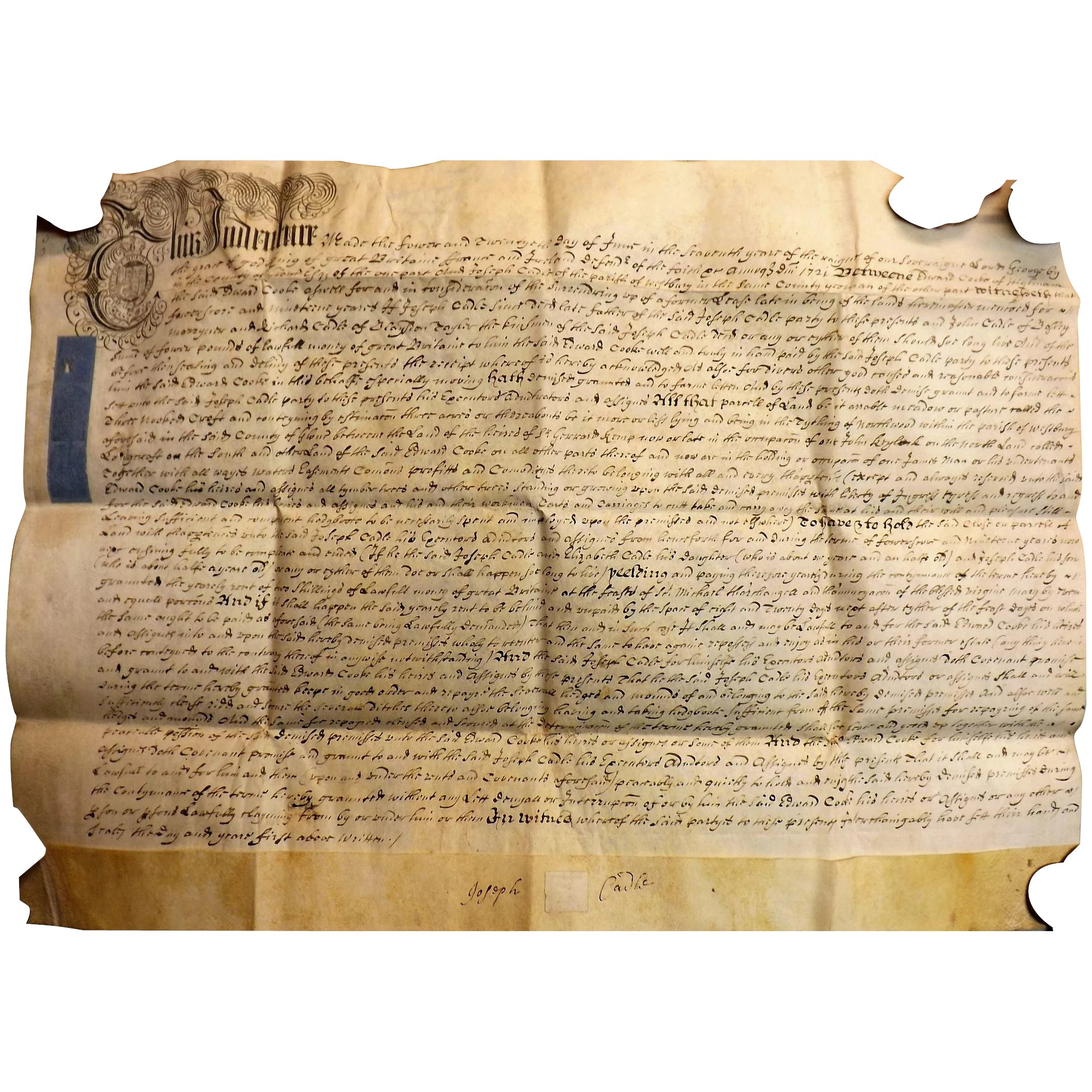Old Vellum INDENTURE DOCUMENT dating to 1721.....measures 22 1/2" x 16 1/2"...in very good condition...has been stored in a folded state fro a couple of hundred years or so.Indentures" are legal contracts, and are entirely written by hand (in English) on large sheepskins, in keeping with legal practice dating back to Medieval times. Today, these ancient British legal manuscripts are prized collector's items, and make impressive decorator accents when matted and framed. The top edge of the document shows the wavy, or "indented" margin that gives these documents their name; as a safeguard against counterfeiting, the copies given to all parties were placed together and cut in this margin in a wavy, irregular pattern, thus uniquely identifying the authenticity of each copy. By convention in common use after about 1675, the documents open with the title "This Indenture" in large capital letters. This heading, written in the earlier examples and printed on the later specimens, is often further embellished with decorative flourishes or occasionally a copper engraved representation of the Arms of the Royal Order of the Garter (called an Armorial heading), reproducing a motif seen on contemporary silver coinage. The text conventionally continues by stating the name and year of reign of the current Sovereign, his or her titles (this format is not used on all documents, and of course is lacking on items from the years of the Commonwealth and on a few pieces immediately following "the Glorious Revolution" in 1688-89. The practice was largely abandoned after the 1790's as the prestige of the monarchy declined and was all but abandoned in Queen Victoria's long reign). The A.D. year is almost invariably stated next, verifying the age of the document. The documents then state the specifics concerning the parties involved in the transaction, its nature, and all pertinent information. Originally rather dry and legalistic, such content today forms a remarkably vivid testimony to the interests and customs of these long-gone times. Such familiar subjects as deeds (conveyances), mortgages, assignments, and leases are their subjects, along with archaic legalisms such as "feoffment", a term from the Middle Ages. Documents after the Licencing Act of 1694 feature embossed paper-and-foil tax stamps, much like the sort that caused so much discontent on this side of the Atlantic. As demands on the Exchequer grew, so did the price of the stamped vellum, from a few pence a sheet to as high as four pounds in the early 1800's, a veritable fortune in the period of these documents. On verso (the back side of the sheet) the documents are docketed by the King's tax collectors, with the now-conventional phrase, that the document was 'signed, sealed, and delivered' by those individuals, whose signatures attest to this fulfillment of the law. All documents are completed by the additions of the signatures of the parties - or an indication of "X, His Mark" in the case of those unable to write. These are accompanied by wax seals bearing impressions of the lawyers', or parties' signet rings. In the earliest documents these fragile seals are appended to the body of the document by means of a "gutter tab" which hangs below the vellum sheet. Unfortunately thus not protected from the rigors of handling, most of these early seals are lacking or encountered only in fragments. In the later manuscripts the seals are applied directly to the document by means of a small tab of cloth slipped through a slot in a double folded bottom margin. Thus seals from the middle of the18th century and later are generally found in a more well-preserved state.
Price:
NZ$ 226.00 including GST
160319x12418
Other products you might be interested in
| Top |


